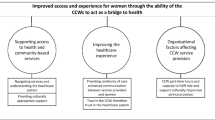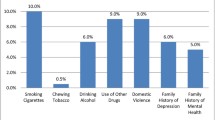Abstract
Various policies, plans and initiatives have been implemented to provide safe, quality and culturally competent care to patients within Queensland’s health care system. A series of models of maternity care are available in Queensland that range from standard public care to private midwifery care. The current study aimed to determine whether identifying as culturally or linguistically diverse (CALD) was associated with the perceived safety, quality and cultural competency of maternity care from a consumer perspective, and to identify specific needs and preferences of CALD maternity care consumers. Secondary analysis of data collected in the Having a Baby in Queensland Survey 2012 was used to compare the experiences of 655 CALD women to those of 4049 non-CALD women in Queensland, Australia, across three stages of maternity care: pregnancy, labour and birth, and after birth. After adjustment for model of maternity care received and socio-demographic characteristics, CALD women were significantly more likely than non-CALD women to experience suboptimal staff technical competence in pregnancy, overall perceived safety in pregnancy and labour/birth, and interpersonal sensitivity in pregnancy and labour/birth. Approximately 50 % of CALD women did not have the choice to use a translator or interpreter, or the gender of their care provider, during labour and birth. Thirteen themes of preferences and needs of CALD maternity care consumers based on ethnicity, cultural beliefs, or traditions were identified; however, these were rarely met. Findings imply that CALD women in Queensland experience disadvantageous maternity care with regards to perceived staff technical competence, safety, and interpersonal sensitivity, and receive care that lacks cultural competence. Improved access to support persons, continuity and choice of carer, and staff availability and training is recommended.


Similar content being viewed by others
References
Australian Commission on Safety and Quality in Healthcare. Australian charter of healthcare rights. 2008. http://safetyandquality.gov.au/wp-content/uploads/2012/01/Charter-PDf.pdf. Accessed 9 April 2014.
Allotey PA, Manderson L, Reidpath D. Addressing cultural diversity in Australian health services. Health Promot J Austr. 2002;13:29–33.
Correa-Velez I, Gifford S, Bice S. Australian health policy on access to medical care for refugees and asylum seekers. Aust New Zeal Health Poli. 2005;2:1–12.
Henderson S, Kendall E, See L. The effectiveness of culturally appropriate interventions to manage or prevent chronic disease in culturally and linguistically diverse communities: a systematic literature review. Health Soc Care Community. 2011. doi:10.1111/j.1365-2524.2010.00972.x.
Murray S, Skull S. Hurdles to health: immigrant and refugee health care in Australia. Aust Health Rev. 2004;29:25–9.
Proctor N. Moving forward together: an international comparison of successful strategies to improve access and equity for people from ethnic minorities. Adelaide: University of South Australia; 2004.
Tribe R, Lane P. Working with interpreters across language and culture in mental health. JMH. 2009;18:233–41.
Carrillo JE, Green AR, Betancourt JR. Cross-cultural primary care: a patient-based approach. Ann Intern Med. 1999;130:829–34.
Willis WO. Culturally competent nursing care during the perinatal period. J Perinat Neonatal Nurs. 1999;13:45–59.
Suh EE. The model of cross cultural competence through an evolutionary perspective. J Transcult Nurs. 2004;15:93–102.
Small R, Rice PL, Yelland J, Lumley J. Mothers in a new country: the role of culture and communication in Vietnamese, Turkish, and Filipino women’s experiences of giving birth in Australia. Women Health. 1999;28:77–101.
Dean RG. The myth of cross-cultural competence. Fam Soc. 2001;82:623–31.
Gustafson DL. Transcultural nursing theory from a critical cultural perspective. Adv Nurs Sci. 2005;28:2–16.
Richardson F, Carryer J. Teaching cultural safety in a New Zealand nursing education program. J Nurs Educ. 2005;44:201–8.
Spence DG. Hermeneutic notions augment cultural safety education. J Nurs Educ. 2005;44:409–14.
Stout MD, Downey B. Nursing, indigenous peoples and cultural safety: so what? Now what? Contemp Nurse. 2006;22:327–32.
Nursing Council of New Zealand. Guidelines for cultural safety, the treaty of Waitangi and Maori health in nursing education and practice. Wellington: New Zealand; 2005.
Queensland Health. Guide to implementing the Queensland multicultural policy 2011 and language services policy in a health context: attachment A to the Queensland Health guideline for multicultural health policy implementation. 2012. http://health.qld.gov.au/qhpolicy/docs/gdl/qh-gdl-080-att-a.pdf. Accessed 6 March 2014.
Queensland Health. Guideline for multicultural health policy implementation. 2012. http://health.qld.gov.au/qhpolicy/docs/gdl/qh-gdl-080.pdf. Accessed 16 Feb 2014.
Queensland Health. Working with interpreters guidelines. 2007. http://health.qld.gov.au/multicultural/interpreters/guidelines_int.pdf. Accessed 28 May 2014.
Queensland Health. Multicultural clinical support resource: cultural dimensions of pregnancy, birth, and postnatal care. 2013. http://health.qld.gov.au/multicultural/support_tools/14MCSR-pregnancy.pdf. Accessed 25 Sept 2014.
Mander R, Melender H. Choice in maternity: rhetoric, reality, and resistance. Midwifery. 2009. doi:10.1016/j.midw.2007.10.009.
Chalmers B. Cultural issues in perinatal care. Birth. 2013;40:217–9.
Chalmers B, Hashi KO. Somali women’s birth experiences in Canada after earlier female genital mutilation. Birth. 2000;27:227–34.
Hatamleh R, Shaban IA, Homer C. Evaluating the experience of Jordanian women with maternity care services. Health Care Women In. 2013. doi:10.1080/07399332.2012.680996.
Henderson J, Gao H, Redshaw M. Experiencing maternity care: the care received and perceptions of women from different ethnic groups. BMC Pregnancy Childbirth. 2013. doi:10.1186/1471-2393-13-196.
Raleigh VS, Hussey D, Seccombe I, Hallt K. Ethnic and social inequalities in women’s experience of maternity care in England: results of a national survey. J Roy Soc Med. 2010;103:188–98.
Higginbottom G, Safipour J, Mumtaz Z, Chiu Y, Paton P, Pillay J. I have to do what I believe: Sudanese women’s beliefs and resistance to hegemonic practices at home and during experiences of maternity care in Canada. BMC Pregnancy Childbirth. 2013. doi:10.1186/1471-2393-13-51.
Harriott E, Williams T, Peterson M. Childbearing in U.S. military hospitals: dimensions of care affecting women’s perceptions of quality and satisfaction. Birth. 2005;32:4–10.
Johnstone M, Kanitsaki O. An exploration of the notion and nature of the construct of cultural safety and its applicability to the Australian health care context. J Transcult Nurs. 2007. doi:10.1177/1043659607301304.
Green JM. Integrating women’s views into maternity care research and practice. Birth. 2012;39:291–5.
Radermacher H, Feldman S. Review of literature concerning the delivery of community aged care services to ethnic groups: mainstream versus ethno-specific services: it’s not an either or. Victoria: Ethnic Communities Council of Victoria; 2008.
Schouten BC, Meeuwesen L. Cultural differences in medical communication: a review of the literature. Patient Educ and Couns. 2006;64:21–34.
Flores G. The impact of medical interpreter services on the quality of health care: a systematic review. Med Care Res Rev. 2005;62:255–99.
Goodman P, Mackey M, Tavakoli A. Factors related to childbirth satisfaction. J Adv Nurs. 2004;46:212–9.
Hennegan J, Redshaw M, Miller Y. Born in another country: women’s experience of labour and birth in Queensland, Australia. Women Birth. 2014. doi:10.1016/j.wombi.2014.02.002.
Brach C, Fraser I. Can cultural competency reduce racial and ethnic disparities? A review and conceptual model. Med Care Res Rev. 2000;57:181–217.
Dragan A. The importance of addressing linguistic ethno-cultural diversity in the delivery of public health services: a literature review. Queensland: Australia; 2009.
Karliner LS, Jacobs EA, Chen AH, Mutha S. Do professional interpreters improve clinical care for patients with limited English proficiency? A systematic review of the literature. Health Serv Res. 2007;42:727.
Queensland Health. Guide to informed decision-making in healthcare. 2012. http://health.qld.gov.au/consent/documents/ic-guide.pdf. Accessed 11 Sept 2014.
Carolan M. Pregnancy health status of sub-Saharan refugee women who have resettled in developed countries: a review of the literature. Midwifery. 2010;26:407–14.
Murray L, Windsor C, Parker E, Tewfik O. The experiences of African women giving birth in Brisbane, Australia. Health Care Women. 2010;31:458–72.
Miller YD, Thompson R, Prosser SJ, Armanasco A, Porter J. The having a baby in Queensland survey 2012. 2012. http://www.qcmb.org.au/media/pdf/2012SingletonSurvey.pdf. Accessed 5 Feb 2014.
Miller YD, Thompson R, Prosser SJ, Armanasco A, Porter J. The having a baby in Queensland survey 2012 [Data file]. 2013. Available from http://www.qcmb.org.au/survey_program_accessing_survey_data.
Prosser SJ, Miller YD, Armanasco A, Hennegan J, Porter J, Thompson R. Findings from the having a baby in Queensland survey. 2013. http://www.qcmb.org.au/reports/menu/publications_downloads. Accessed 2 May 2014.
Carey RG, Posavac EJ. Using patient information to identify areas for service improvement. Health Care Manag R. 1982;7:43–8.
Small R, Yelland J, Lumley J, Brown S, Liamputtong P. Immigrant women’s views about care during labour and birth: an Australian study of Vietnamese, Turkish, and Filipino women. Birth. 2002;29:266–77.
Stevens G, Thompson R, Kruske S, Watson B, Miller YD. What are pregnant women told about models of maternity care in Australia? A retrospective study of women’s reports. Patient Educ Couns. 2014. doi:10.1016/j.pec.2014.07.010.
Correa-Velez I, Ryan J. Developing a best practice model of refugee maternity care. Women Birth. 2012;25:13–22.
Phiri J, Dietsch E, Bonner A. Cultural safety and its importance for Australian midwifery practice. Collegian. 2010;17:105–11.
Sandall J, Devane D, Soltani H, Hatem M, Gates S. Improving quality and safety in maternity care: the contribution of midwife-led care. J Midwifery Wom Health. 2010;55:255–61.
Cioffi J. Caring for women from culturally diverse backgrounds: midwives’ experiences. J Midwifery Wom Health. 2004. doi:10.1016/j.jmwh.2004.01.019.
Schmied V, Cooke M, Gutwein R, Steinlein E, Homer C. Time to listen: strategies to improve hospital-based postnatal care. Women Birth. 2008;21:99–105.
Kirkham M. The culture of midwifery in the National Health Service in England. J Adv Nurs. 1999;30:732–9.
Bruggemann O, Parpinelli M, Osis M, Cecatti J, Neto A. Support to woman by a companion of her choice during childbirth: a randomized controlled trial. Reprod Health. 2007;4:1–7.
Hodnett E, Gates S, Hofmeyr G, Sakala C (2006) Continuous support for women during childbirth. Cochrane Lib. 2006;4:CD.003766.
Sauls D. Adolescents’ perception of support during labour. J Perinat Educ. 2004;13:36–42.
McKinnon LC, Prosser SJ, Miller YD. What women want: qualitative analysis of consumer evaluations of maternity care in Queensland, Australia. 2014; doi:10.1186/s12884-014-0366-2.
Chalmers B. Cross-cultural comparisons of birthing: psycho-social issues in Western and African birth. Psychol Health. 1996;12:11–21.
Sterling L, Hawes E, Phung H, Wong KY. Client perceptions on the quality of the Queensland Health interpreter service. 2012. http://health.qld.gov.au/multicultural/interpreters/Comm-fb-rep-2012.pdf. Accessed 25 Sept 2014.
Queensland Government. Language services policy review. 2014. http://datsima.qld.gov/resources/datsima/culturaldiversity/publications/lsp-review-report.pdf. Accessed 25 Sept 2014.
McEldowney R, Connor MJ. Cultural safety as an ethic of care: a praxiological process. J Transcult Nurs. 2011. doi:10.1177/104365961141439.
Acknowledgments
The data on which this report is based was collected as part of the Having a Baby in Queensland Survey Program of the Queensland Centre for Mothers & Babies at The University of Queensland. We are grateful to Queensland Government for funding and to the women who provided survey data. The Queensland Registry of Births, Deaths and Marriages contacted women to invite them to participate on behalf of the Queensland Centre for Mothers & Babies to ensure women’s privacy was protected. We gratefully acknowledge Dr. Rachel Thompson for her conception and design of the Having a Baby in Queensland Survey Program with Associate Professor Miller. We are grateful to Dr. Samantha Prosser and the Queensland Centre for Mothers & Babies Survey Program team for their contribution to the design and management of data collection. Anna Voloschenko from the Ethnic Communities Council of Queensland advised on the definition of CALD for application in this research and her contribution is gratefully acknowledged.
Informed Consent
All procedures followed were in accordance with the ethical standards of the responsible committee on human experimentation (institutional and national) and with the Helsinki Declaration of 1975, as revised in 2000. Informed consent was obtained from all individuals who participated in this study.
Conflict of interest
Yvette Miller declares that she has no conflict of interest. Sarah Mander declares that she is now an employee of Queensland Health but was not at the time that this research was conducted.
Author information
Authors and Affiliations
Corresponding author
Rights and permissions
About this article
Cite this article
Mander, S., Miller, Y.D. Perceived Safety, Quality and Cultural Competency of Maternity Care for Culturally and Linguistically Diverse Women in Queensland. J. Racial and Ethnic Health Disparities 3, 83–98 (2016). https://doi.org/10.1007/s40615-015-0118-7
Received:
Revised:
Accepted:
Published:
Issue Date:
DOI: https://doi.org/10.1007/s40615-015-0118-7




